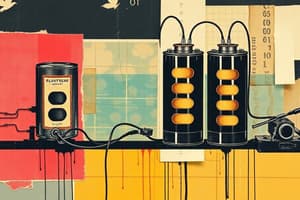Podcast
Questions and Answers
What is the main function of an electrochemical cell?
What is the main function of an electrochemical cell?
- Prevent oxidation and reduction reactions
- Convert chemical energy into electrical energy (correct)
- Convert electrical energy into chemical energy
- Generate heat energy from chemical reactions
Which component connects the two half-cells in an electrochemical cell?
Which component connects the two half-cells in an electrochemical cell?
- Salt bridge (correct)
- Glass tube
- Wire
- Porous membrane
Which electrode is responsible for oxidation in an electrochemical cell?
Which electrode is responsible for oxidation in an electrochemical cell?
- Electrolyte
- Cathode
- Anode (correct)
- Redox
Which electrode is typically more negative in potential in an electrochemical cell?
Which electrode is typically more negative in potential in an electrochemical cell?
What is the classification of electrochemical cells that convert chemical energy into electrical energy?
What is the classification of electrochemical cells that convert chemical energy into electrical energy?
Which type of cell can drive non-spontaneous chemical reactions using electrical energy?
Which type of cell can drive non-spontaneous chemical reactions using electrical energy?
What is the primary function of a galvanic cell?
What is the primary function of a galvanic cell?
Which process involves the reduction of a metal ion at the cathode and the oxidation of another species at the anode?
Which process involves the reduction of a metal ion at the cathode and the oxidation of another species at the anode?
What are fuel cells primarily used for?
What are fuel cells primarily used for?
What is the purpose of electroplating in the automotive industry?
What is the purpose of electroplating in the automotive industry?
Which type of cell converts electrical energy into chemical energy?
Which type of cell converts electrical energy into chemical energy?
What is the process used to split water into hydrogen and oxygen using an electric current called?
What is the process used to split water into hydrogen and oxygen using an electric current called?
Flashcards are hidden until you start studying
Study Notes
Electrochemical Cells: Exploring the Interplay of Chemistry and Electricity
Electrochemistry is a discipline that unites chemistry and electricity, shedding light on the intricate dance between charged particles and chemical reactions. At the heart of electrochemistry, we find the electrochemical cell, a device that converts chemical energy into electrical energy and vice versa. In this article, we'll explore the fundamental concepts and applications of electrochemical cells.
Components of an Electrochemical Cell
An electrochemical cell consists of two half-cells, each containing a redox (reduction and oxidation) reaction. A redox reaction occurs when electrons are transferred between two species, resulting in a change of oxidation state. These half-cells are connected by a conductor, typically a salt bridge or a porous membrane, which allows ions to pass through while preventing the mixing of the solutions.
Inside each half-cell is a pair of electrodes. The electrode where oxidation occurs is called the anode, and the electrode where reduction happens is called the cathode. The electrode at which the reduction occurs is typically more negative in potential, while the electrode at which oxidation occurs is more positive.
Galvanic and Electrolytic Cells
Electrochemical cells can be classified into two categories: galvanic and electrolytic cells. A galvanic cell, also referred to as a voltaic cell, converts the chemical energy stored in a spontaneous redox reaction into electrical energy. An example of a galvanic cell is a common dry cell, where the oxidation of zinc (Zn) and the reduction of manganese dioxide (MnO₂) produce electricity.
Conversely, an electrolytic cell converts electrical energy into chemical energy, often by causing non-spontaneous redox reactions to occur. Electrolysis, a process used in the industrial production of metals, is an example of an electrolytic cell. In electrolysis, an electric current is passed through an electrolyte, causing the reduction of a metal ion at the cathode and the oxidation of another species at the anode.
Applications of Electrochemical Cells
Electrochemical cells have a diverse array of applications, including the production of electricity, batteries, fuel cells, and electroplating.
- Batteries: Electrochemical cells are the foundation of batteries, devices that store electrical energy. Batteries often consist of multiple cells connected in series or parallel to achieve the desired voltage and current capacity.
- Fuel cells: Fuel cells are electrochemical devices that convert chemical energy stored in a fuel, such as hydrogen, into electricity. They are gaining attention as a clean and efficient source of power for vehicles, electricity generation, and portable devices.
- Electroplating: Electroplating is an electrochemical process used to deposit a thin layer of metal onto a surface. This process is commonly used in the automotive, aerospace, and electronics industries to improve corrosion resistance, wear resistance, or appearance of a part.
- Water electrolysis: Water electrolysis is the process of splitting water into hydrogen and oxygen using an electric current. Hydrogen produced from water electrolysis can be used as a clean and renewable energy source for various applications, including the production of ammonia and hydrogen fuel cells.
Summary
Electrochemical cells are an indispensable part of electrochemistry, offering a wealth of insights and applications. By understanding electrochemical cells and their components, we can begin to grasp the relationship between chemical reactions and electrical energy, which is crucial to developing modern technologies and solving global challenges. As we delve deeper into the world of electrochemistry, we will continue to uncover new possibilities for the efficient conversion of energy and the advancement of sustainable technologies.
References: Grasshoff, K. (2006). Introduction to Electrochemistry. Springer Science & Business Media. ACS Publications (2016). Introduction to Electrochemistry. American Chemical Society. Analog Devices (2021). Introduction to Batteries and Electrochemical Cells. Analog Devices. J. Power Sources (2019). Advances in Fuel Cells. Elsevier. Encyclopedia Britannica (2022). Electroplating. Encyclopedia Britannica. Department of Energy (2023). Water Electrolysis. United States Department of Energy.
Studying That Suits You
Use AI to generate personalized quizzes and flashcards to suit your learning preferences.




